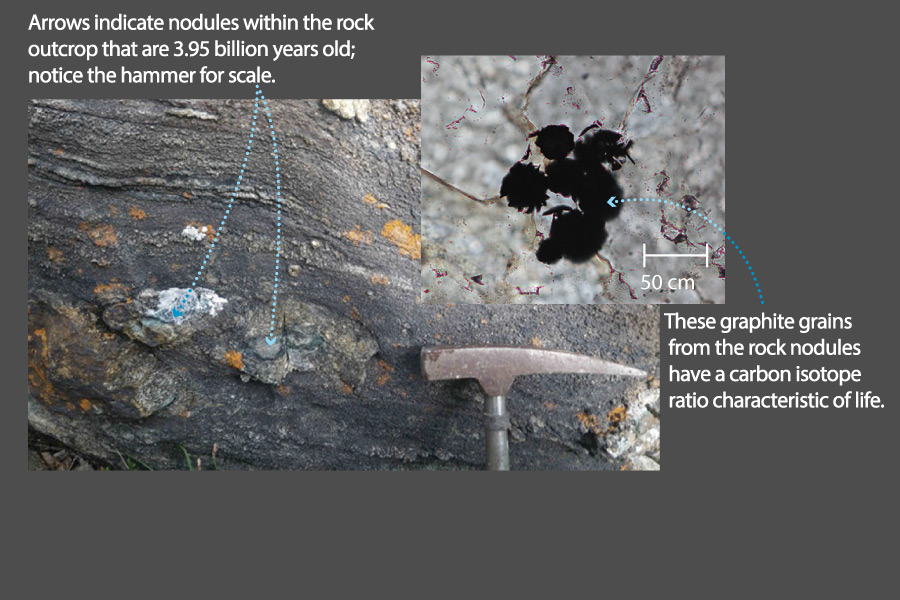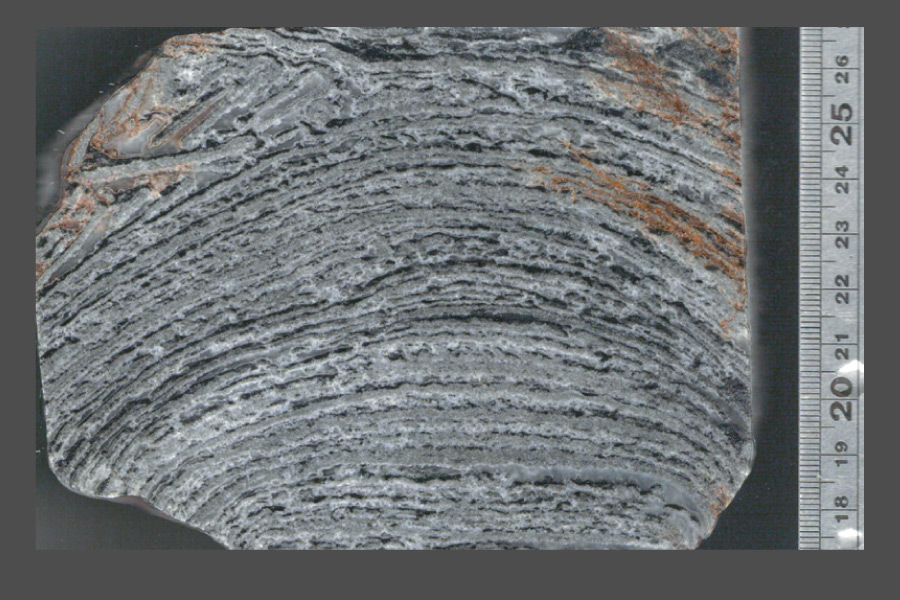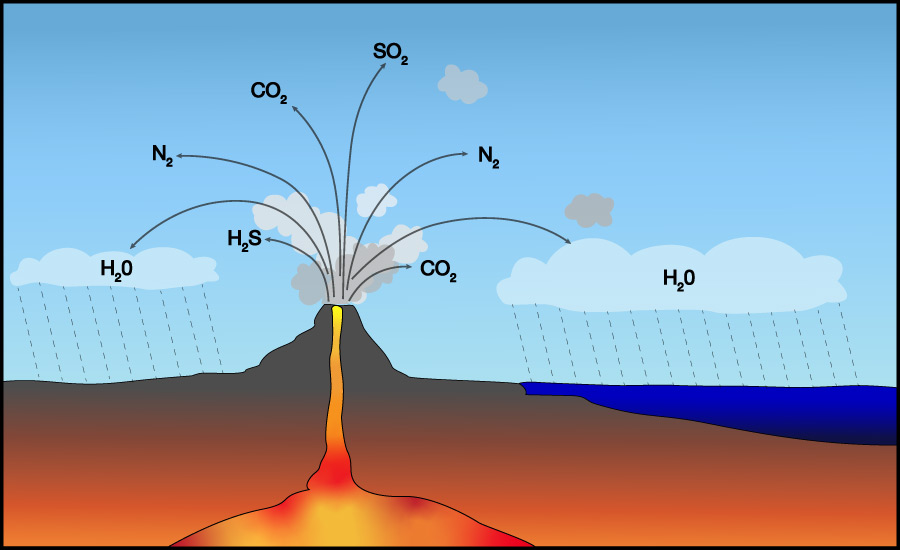Scientists have now been studying Earth’s rock and fossil record for centuries. As a result, we now know a lot about the changes that have occurred on our planet through time, even though we still have much more to learn. The geological time scale shown in Figure 5.4–1 (repeated below) summarizes a few of the most important known events in Earth’s history. In this section, we’ll briefly discuss each of these events.
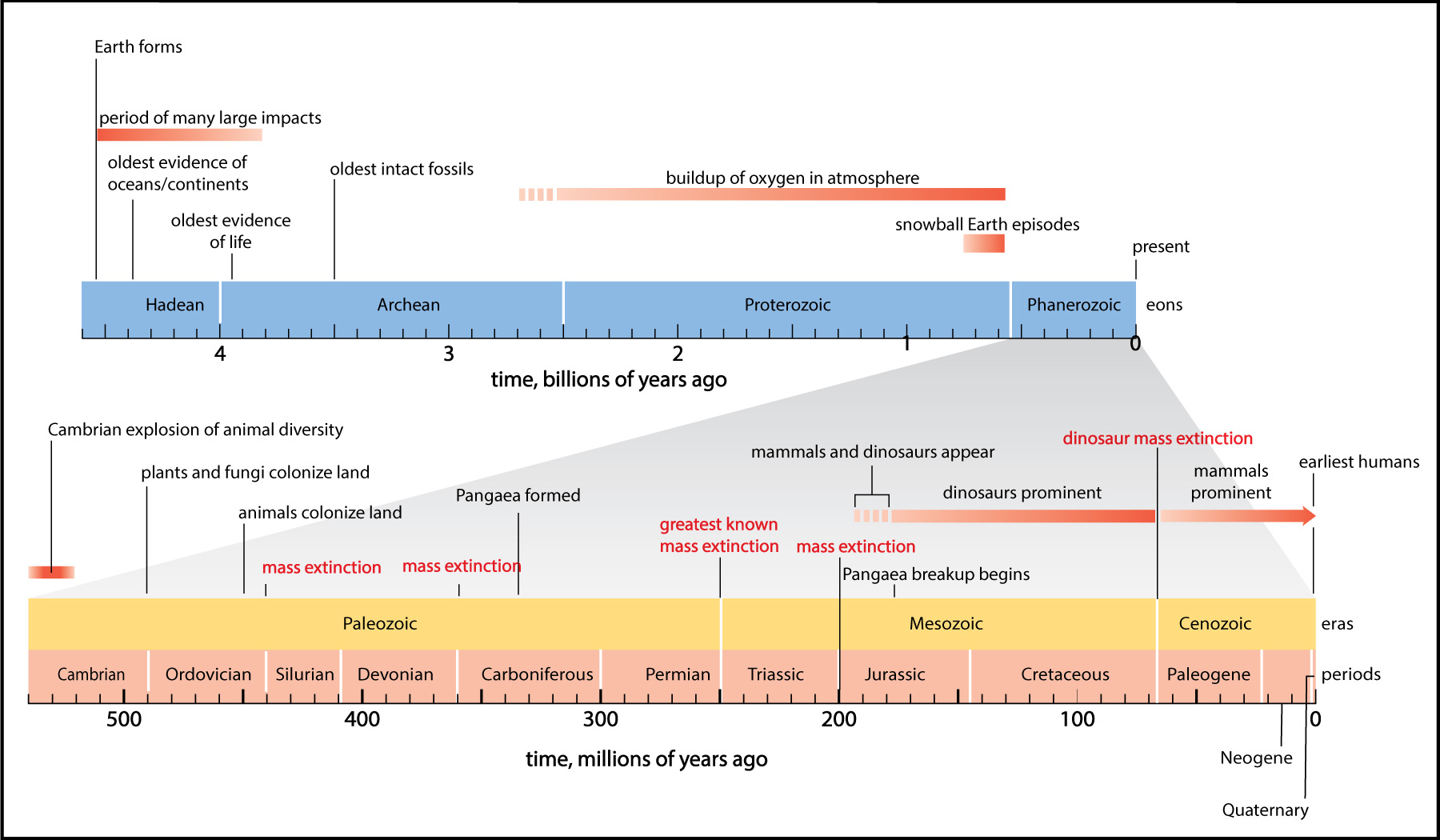
Quiz
Before you continue, make sure you understand how to read the timeline in Figure 5.4–1 by answering the following quiz questions.
Note: As always, after you finish the quiz, be sure you read the feedback that explains the correct answers, to make sure you understand the reasons for these answers.
The First Four Billion Years
One of the first things you probably noticed as you studied Figure 5.4–1 is that most of the time scale doesn’t show very much. More specifically, it shows only a few events (and only three named time intervals) for the entire first four billion years of Earth’s history. In contrast, there is much more detail in the lower bar that zooms in on the most recent half-billion years. Nevertheless, events of Earth’s first four billion years were obviously critical to making it possible for us to be here today.
Discussion
Lack of Detail in Earth’s First Four Billion Years
Generally speaking, there are two possible reasons why scientists might have identified less detail for Earth’s first four billion years than for more recent times:
- Possible reason 1: Not much happened during the first four billion years.
- Possible reason 2: A lot happened, but we don’t know very much about it compared to what we know about more recent times.
Discuss the following questions about these two possibilities in small groups or as a class.
- Consider the first possible reason. Can you think of any reason why the number of notable events on Earth might have become greater in more recent times?
- Now consider the second possible reason. Based on what you have learned about rocks and fossils, identify two reasons why finding fossils from the first four billion years is much more difficult than finding them from more recent times.
- Overall, which of the two possible reasons do you think is more likely, or do you think it was some combination of them? Defend your opinion.
This discussion is intended to make sure students think about the relative lack of detail shown for the first four billion years before you continue on. Notes:
- (1) Students should remember that the events shown on the geological time scale are based on careful study of the fossil record, which means many of the events are tied to the evolution of life. The timeline itself offers at least some evidence that evolution has accelerated in more recent times compared to the first four billion years. For example, the Cambrian explosion marks a vast diversification of animal and plant life, and all the other changes we’ve seen in animal species can only have happened after that. You might suggest an analogy to the way that human technological development has accelerated in recent human history.
- (2) This may be a challenging question, but the two major reasons why study of the first four billion years is more difficult are: (1) The constant changes that occur on Earth’s surface means that most older rocks and fossils are likely to have been destroyed by now. (2) During the first 4 billion years, most life was microscopic, which means that even when fossils still exist, they are also microscopic and therefore much more difficult to find and identify. Note that we discussed the latter idea briefly in Section 5.1.2.
- (3) There’s room for legitimate debate on the best answer, but most scientists would say it is a combination of the two reasons. In other worlds, the first 4 billion years are much more difficult to study, but there also has been some acceleration of notable events in the past half-billion years. For your background: Some evolutionary biologists disagree with the idea of an acceleration, pointing out that the Cambrian explosion really marks an “explosion” only in the diversity of “large” life like plants and animals. In order for this explosion to have been possible, there must already have been great diversity in the genomes of the microbes and small organisms that predated it. As a result, some biologists argue that the general rate of evolution has stayed fairly constant throughout time.
The timeline begins with Earth’s formation, which you already know to have occurred about 4½ billion years ago. The “period of many large impacts” continued for about a half-billion years after that (the time period called the “Hadean eon”), which may be why we do not see evidence of life during this time. Still, the timeline shows that scientists have found at least some evidence suggesting that Earth already had oceans and continents by the end of that period. Some geologists think that the crust may also have broken into plates by that time, in which case the geology of plate tectonics would already have been under way.
Three of the other events shown for the first four billion years are related to the emergence of life:
- The “oldest evidence of life” dates to 3.95 billion years ago (see Slide 7 from Slide Show 5.1.2–1). As we discussed in Section 5.1.2, this evidence comes not from intact fossils but instead from careful study of the amounts of carbon of different types. Still, this evidence is considered quite strong, making it very likely that early life existed by that time.
- The “oldest intact fossils” date to about 3.5 billion years ago. As we also discussed in Section 5.1.2, these include both microfossils (fossils of microscopic organisms) and stromatolites that are thought to be the fossilized remains of large colonies of microorganisms (see Slide 4 from Slide Show 5.1.2–1).
- The “buildup of oxygen in atmosphere” is also related to life . Recall that Earth’s early atmosphere came from outgassing by volcanoes, and these gases did not include oxygen (see Figure 5.2.1–5). So where did Earth get its oxygen? As you’ve probably realized, the oxygen came from photosynthesis, a process that takes in carbon dioxide and releases oxygen. Today, when we think about photosynthesis, we usually think about plants. However, the buildup occurred before plants evolved and was due primarily to photosynthesis by microscopic organisms similar to those shown in Figure 5.4.1–2.
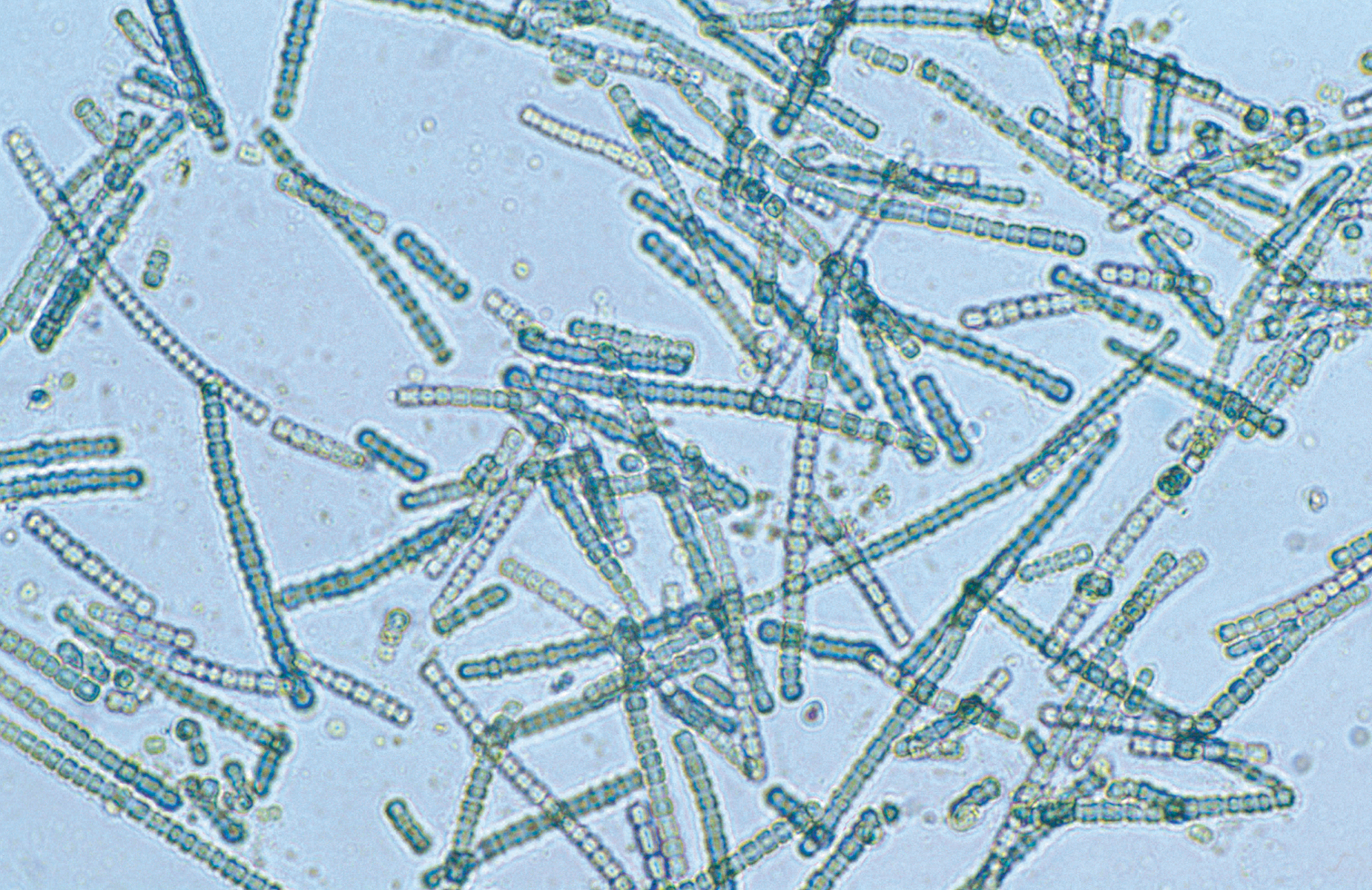
The last event shown on the time line for Earth’s first four billion years is labeled “snowball Earth episodes.” We won’t discuss these much in this book, but in brief: Geologists say that Earth was a “snowball” when it was in such a deep ice age that glaciers covered almost the entire planet. Notice that the red bar shows that the snowball episodes occurred over a period of almost 200 million years. Scientists still don’t know very much about these episodes, but geological evidence suggests there were at least three snowball episodes, and that Earth became unusually hot in between these deep ice ages. This cycling between extreme cold and extreme heat would presumably have put a lot of evolutionary pressure on the life existing at the time. In fact, some scientists think that this pressure may have helped cause the sudden “explosion” of plant and animal life that occurred not too long after the snowball episodes ended.
The Rise of Plants and Animals
After the first four billion years, the amount of detail on our timeline increases so dramatically that we have to zoom in to see the rest of it. Notice that this zoom-in begins with something called the “Cambrian explosion of animal diversity.” It gets the name “explosion” because geologists discovered that rock layers from before this time contain very few animal fossils, and after this time they contain a lot of animal fossils. In other words, it is called an “explosion” because it happened in a geologically short time period.
Discussion
A Geological “Explosion”
Notice that the Cambrian “explosion” actually occurred over a period of some 40 million years. In what sense is it reasonable to refer to this as an “explosion”? Are there any geological events that “explode” on time scales that are more like the explosions of bombs?
This can be a very brief discussion. It is intended to once again remind students that when we think on geological time scales, we have to redefine ordinary words like “recent” or “short time” or “explosion.” For the second part of the question, students should realize that events like volcanic eruptions, landslides, and earthquakes do indeed “explode” on time scales similar to bomb explosions.
Notice that it wasn’t until considerably later that we see events labeled “plants and fungi colonize land” and “animals colonize land.” Try the following questions to make sure you understand the implications of these events.
Discuss the following questions with a classmate. Then click to open the answers to see if they agree with what you came up with.
- Suppose you had a time machine and visited Earth shortly before the event marked “plants and fungi colonized the land.” What would you have found?
You would not have seen any plants, fungi, or animals anywhere on dry land; you could have found them only in the oceans. (It is possible that microscopic life was already living on land, though no one yet knows whether this was the case.)
- Approximately when did plants and fungi colonize the land?
The time line shows that this occurred about 475 million years ago.
- Approximately when did animals colonize the land?
The time line shows that this occurred about 415 million years ago.
- Is there a reason why animals colonized the land after plants and fungi?
Yes: animals could not live on the land until there was food for them to eat.
The rest of the events marked on the time line are probably already familiar to you, but let’s briefly highlight a few:
- The timeline shows when the super-continent of Pangaea formed and began to break up. Remember that the breakup took time. For example, South America and Africa did not fully separate until about 110 million years ago (recall this earlier Activity), even though other parts of Pangaea broke away much earlier.
- Notice that mammals and dinosaurs first appeared around the same time (a little more than 200 million years ago). However, for more than 100 million years, dinosaurs were much more prominent on Earth (as revealed in the fossil record).
- The earliest humans don’t appear until the very end of the time line. In other words, we are a very recent arrival on a 4½-billion-year-old planet.
Activity
Time Line Revisited
Look back at the timeline you made in Chapter 4, and in particular at the 6 events you labeled on it for the Activity “Time Line Part 2.” Compare your time line to the geological time scale shown in Figure 5.4–1. Do you see the correspondence? Briefly discuss each of the 6 events you labeled. What do you know about them that you did not know when you first labeled them? How does your new understanding affect the way you think about time and Earth?
This activity is mostly a discussion, but requires getting back out the time line made earlier. The goal is for students to realize that while they probably chose their 6 events to label almost at random when they first made the time line, they now should have a fairly deep understanding of what they mean.
Mass Extinctions
There’s one last set of labels on Figure 5.4–1: the events labeled as “mass extinctions .” We’ve already discussed one of these. You’ll recognize the one labeled “greatest known mass extinction” as the “end-Permian” mass extinction that we discussed in Section 5.2.3. But you can now see that the end-Permian event is just one of five identified mass extinctions in geological history, so you might wonder about the others.
Recall that a mass extinction is an event in which a large fraction (at least about half) of the species living on Earth all go extinct in a geologically short period of time. The end-Permian event is the “greatest” of these in the sense that it caused the largest loss of species. But all five mass extinctions were devastating events for the life of those times.
Scientists are still investigating the details of what happened in these mass extinctions and debating what caused them . Recall that end-Permian extinction has been linked to the massive volcanic eruptions that created the Siberian traps (see Figure 5.2.3–17), and the leading hypothesis suggests that the extinctions occurred because of extreme global warming that was triggered by the eruptions. Three of the other four mass extinctions also seem likely to have been tied to massive eruptions and global warming, though no one yet knows for sure.
The most recent mass extinction, however, seems to have had a different cause. We’ll turn to this extinction event next.
Activity
The Sixth Extinction
You are undoubtedly aware that humans are now causing many species to go extinct. In fact, scientists estimate that we are now driving plant and animal species to extinction at a rate far above the average rate over geological history. The exact rate isn’t known (it’s surprisingly difficult to measure), but most estimates suggest that we’ve already driven at least 5% of Earth’s species to extinction during the past few centuries. This could easily worsen in the future, and many scientists worry that we could drive half or more of Earth’s species to extinction within the next few centuries. Work in small groups to research and discuss the following questions.
- Suppose that humans actually do end up driving half of Earth’s species to extinction, and that all this extinction occurs over a period of less than 1,000 years. How wide of a band would represent 1,000 years on the geological time scale of Figure 5.4–1? What length of string represents 1,000 years on the time line you made in Chapter 4?
- Based on your answer to question (1), do you think that this type of extinction “event” would qualify as a mass extinction? Why or why not?
- Scientists who are concerned about the possibility that we could cause a mass extinction often refer to this possibility as the “sixth extinction.” What do you think they mean?
- Look up one animal that has been lost to extinction in the past few centuries, such as the dodo or the passenger pigeon (Figure 5.4.1–3). Briefly discuss what happened, and how it makes you feel to know this animal is gone forever.
- Bonus: What are “endangered species”? What kinds of steps are being taken to try to save them? Do you think these steps are adequate?
- Bonus: Learn about and discuss how scientists estimate the current extinction rate, and why it is so difficult to measure precisely.

This activity is designed to help students understand the impact we are now having on biological diversity. Notes:
- (1) The key to this question is for students to recognize that 1,000 years is so short compared to the geological time scale that it is essentially too small to be seen on both Figure 5.4–1 and on their string time line. Recall that in the Chapter 4 Activity “Timeline for Earth”, students would already have calculated the length that corresponds to 1,000 years on their own timelines.
- (2) Because the extinction event would be so narrow on the time scale, it would qualify as a mass extinction.
- (3) It is referred to as the “sixth” extinction because, as students have learned above, there are five identified mass extinctions in the fossil record. This one would therefore be the sixth.
- (4) We hope by learning about a famous extinction, such as the dodo or passenger pigeon, students will recognize the sadness of the permanent loss of a species.
- (5) This “bonus” question can be the subject of as much research or class discussion as you wish. You might even wish to discuss legislation intended to protect endangered species, such as the Endangered Species Act in the United States.
- (6) This is a very challenging “bonus” question, but can be useful in helping students understand how difficult some seemingly simple measurements can be. In this case, one major source of uncertainty comes from the fact that biologists do not have a complete inventory of the existing species, and without such inventory, there’s no way to know for sure how many are going extinct. As a result, most estimates are based on isolated sample studies, such as on islands, leaving great uncertainty in how well these samples translate to the entire world.
